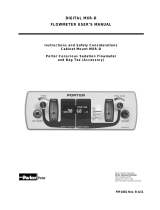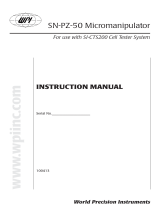
14
a) Use a gas mixture controller to obtain a defined mixture
of nitrous oxide and nitrous oxide-free inert bulk carrier gas
from a gas tank (e.g. N2) . For instance, to obtain a nitrous oxide
concentration of 100 µM in the calibration chamber at 20°C,
bubble the water in the calibration chamber with a gas mixture
containing 1 atm. N2 and 0,003679 atm. N2O (nitrous oxide partial
pressure 0.003679 atm. * solubility 27,05*10-3 mol/liter/atm. =
100 µmol/liter, see Table 1). For a Unisense 300 ml calibration
chamber CAL300, 5 minutes of bubbling at a rate of 5 L per minute
is sufficient time to achieve 99% of the concentration. If the
equipment (gas mixture controller) is available, this method can
be convenient, because it is possible to switch between different
nitrous oxide levels without changing the water. Use the solubility
table (Table 1) to find the correct mixture at temperatures other
than 20°C. For obtaining correct concentrations it is important
that the headspace above the water in the calibration chamber
is closed except for one hole, which should be only slightly larger
than the microsensor shaft. This effectively prevents ambient air
from entering the vessel. We recommend the Unisense Calibration
chamber, CAL300, and rubber stoppers for calibrations.
b) Add a defined volume of nitrous oxide saturated water to a
defined volume of water in a calibration chamber. For instance
adding 3,679 ml of nitrous oxide saturated to 996,32 ml water
gives a concentration of 100 µM at 20°C (see Table 1), as 3,679 ml
of nitrous oxide saturated water contains 100 µmol nitrous oxide.
Using a calibration chamber containing 200 ml, reduce the volume
of added nitrous oxide saturated
water by a factor of 5 for obtaining
100 µM, and so on. After adding
nitrous oxide-saturated water to
the calibration chamber, mix it
thoroughly for a few seconds and
read the signal when it is stable.
Do not stir bubbles into the water
and do not mix by bubbling, as
this will flush nitrous oxide from
the water. A magnetic stirrer is
Calibration chamber CAL300
* Do not apply for high range sensor versions.





































